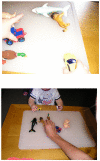The development of object categorization in young children: hierarchical inclusiveness, age, perceptual attribute, and group versus individual analyses
- PMID: 20210495
- PMCID: PMC2856652
- DOI: 10.1037/a0018411
The development of object categorization in young children: hierarchical inclusiveness, age, perceptual attribute, and group versus individual analyses
Abstract
Multiple levels of category inclusiveness in 4 object domains (animals, vehicles, fruit, and furniture) were examined using a sequential touching procedure and assessed in both individual and group analyses in eighty 12-, 18-, 24-, and 30-month-olds. The roles of stimulus discriminability and child motor development, fatigue, and actions were also investigated. More inclusive levels of categorization systematically emerged before less inclusive levels, and a consistent advantage for categorizing high versus low perceptual contrasts was found. Group and individual analyses generally converged, but individual analyses added information about child categorization over group analyses. The development of object categorization in young children is discussed in light of efficiency of processing and similarity-differentiation theories.
Figures
Similar articles
-
Categorization of real and replica objects by 14- and 18-month-old infants.Infant Behav Dev. 2012 Jun;35(3):606-12. doi: 10.1016/j.infbeh.2012.04.007. Epub 2012 Jun 27. Infant Behav Dev. 2012. PMID: 22742988 Free PMC article.
-
Specifying the role of function in infant categorization.Infant Behav Dev. 2010 Dec;33(4):672-84. doi: 10.1016/j.infbeh.2010.09.003. Epub 2010 Oct 15. Infant Behav Dev. 2010. PMID: 20951437 Free PMC article.
-
Developmental changes in children's understanding of the similarity between photographs and their referents.Dev Sci. 2008 Jan;11(1):156-70. doi: 10.1111/j.1467-7687.2007.00660.x. Dev Sci. 2008. PMID: 18171376
-
The neuroscience of perceptual categorization in pigeons: A mechanistic hypothesis.Learn Behav. 2018 Sep;46(3):229-241. doi: 10.3758/s13420-018-0321-6. Learn Behav. 2018. PMID: 29532328 Review.
-
Categorization of visual stimuli in the honeybee Apis mellifera.Anim Cogn. 2006 Oct;9(4):257-70. doi: 10.1007/s10071-006-0032-9. Epub 2006 Aug 15. Anim Cogn. 2006. PMID: 16909238 Review.
Cited by
-
A Computational Approach towards Visual Object Recognition at Taxonomic Levels of Concepts.Comput Intell Neurosci. 2015;2015:905421. doi: 10.1155/2015/905421. Epub 2015 Jun 22. Comput Intell Neurosci. 2015. PMID: 26185494 Free PMC article.
-
Assessing categorization performance at the individual level: a comparison of Monte Carlo simulation and probability estimate model procedures.Infant Behav Dev. 2011 Apr;34(2):321-6. doi: 10.1016/j.infbeh.2011.02.003. Epub 2011 Mar 12. Infant Behav Dev. 2011. PMID: 21402410 Free PMC article.
-
Prerequisite Skills in Cognitive Testing: Innovations in theory and recommendations for practice.Cogn Dev. 2021 Apr-Jun;58:101038. doi: 10.1016/j.cogdev.2021.101038. Epub 2021 Mar 25. Cogn Dev. 2021. PMID: 33833479 Free PMC article.
-
Learning Spoken Words via the Ears and Eyes: Evidence from 30-Month-Old Children.Front Psychol. 2017 Dec 8;8:2122. doi: 10.3389/fpsyg.2017.02122. eCollection 2017. Front Psychol. 2017. PMID: 29276493 Free PMC article.
-
Object sorting into a two-dimensional array in humans and chimpanzees.Primates. 2021 Jan;62(1):29-39. doi: 10.1007/s10329-020-00850-1. Epub 2020 Jul 29. Primates. 2021. PMID: 32728844
References
-
- Adolph KE, Berger SE. Physical and motor development. In: Bornstein MH, Lamb ME, editors. Developmental psychology: an advanced textbook. 5e. Erlbaum; Mahwah, NJ: 2005. pp. 223–282.
-
- Altman D, Machin D, Bryan T, Gardner S. Statistics with confidence: Confidence intervals and statistical guidelines. BMJ Books; London, UK: 2000.
-
- Atran S. Cognitive foundations of natural history: Towards an anthropology of science. Cambridge University Press; New York: 1990.
-
- Baldwin DA, Markman EM, Melartin EM. Infants’ ability to draw inferences about nonobvious object properties: evidence from exploratory play. Child Development. 1993;64:711–728. - PubMed
-
- Bauer PJ, Dow GA, Hertzgaard LA. Effects of prototypicality on categorization in 1- to 2-year-olds: Getting down to basic. Cognitive Development. 1995;10:43–68.


